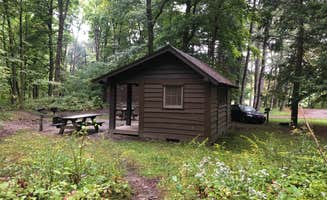Cabins near Harford, New York offer year-round accommodation options within the Finger Lakes region, which features rolling hills ranging from 1,000 to 2,000 feet in elevation. The area experiences four distinct seasons with summer temperatures averaging 70-85°F and winter temperatures often dropping below freezing. Most cabin camping locations sit amid hardwood forests dominated by maple, oak and beech trees, providing natural shade during summer camping periods.
What to do
Waterfall swimming: At Robert H. Treman State Park, visitors can enjoy a natural swimming area beneath a waterfall. "You can swim in the waterfall area here. Need I say more? Actually, it can be VERY busy in the summer time in the swimming area, making it difficult to find your own 'space.' However, the hiking trails are awesome," notes Matt G.
Hiking trails: Many state parks feature interconnected trail systems ranging from easy to strenuous. "Don't let the beginning steps fool you, the rim trail can be very strenuous," warns one visitor about Robert H. Treman. At Taughannock Falls State Park, trails accommodate various skill levels. "Nice camp ground with well-kept bathrooms. Close to hiking trails along the gorge and Cayuga Lake access for swimming and boating," reports Stephanie B.
Wine country exploration: The cabin locations provide convenient access to the Finger Lakes wine region. "Location in the Finger Lakes region makes it a good base camp for winery tours," notes Chris D. about Buttermilk Falls State Park. The Seneca Lake Wine Trail runs through the area and makes for a convenient day trip from most cabin accommodations.
What campers like
Natural surroundings: Rustic cabin rentals typically feature wooded settings with wildlife viewing opportunities. "We woke to snow on the tent. Had a great time listening to the birds and enjoying the trails," shares Scott M. about his fall experience at Robert H. Treman State Park. Deer sightings are common at many locations, particularly at dawn and dusk.
Swimming options: Many parks feature swimming areas that complement the cabin experience. At Chenango Valley State Park, "The beach area is well staffed and clean. Changing areas are available as well as a splash pad for the little kids," according to Fred C. Most swimming areas operate from late May through early September with lifeguards on duty.
Quiet atmosphere: Less developed cabin sites offer more solitude. "The lack of amenities drives a lot of people away—we have never felt crowded while here," mentions Molly G. about Buttermilk Falls State Park. For truly secluded options, cabins at more remote parks tend to have fewer neighbors and less traffic noise.
What you should know
Seasonal availability: Most cabin facilities operate on limited schedules. At Watkins Glen State Park, accommodations are only available "from May 13 to October 10." Each park has different opening and closing dates depending on location and elevation, with higher elevation cabins generally having shorter seasons.
Amenities vary significantly: Basic cabins may have minimal facilities. "Bathrooms are typically located in centralized bathhouses rather than within individual cabins," notes one visitor. At Fillmore Glen State Park, "Bathrooms are modern, kept very clean, and the showers are awesome," according to Shari G.
Reservation requirements: Most cabin locations require advance booking, especially during peak periods. "Reserve ahead of time in summer," advises Harry H. about Buttermilk Falls. Reservations typically open 9 months in advance through the New York State Parks reservation system, with holiday weekends often filling immediately upon availability.
Tips for camping with families
Playground access: Many parks feature play areas for children near cabin sites. Chenango Valley State Park offers "Playgrounds and spaces to ride bikes, swim, picnic, and all-around have fun," according to Kayti D. Most playgrounds are designed for ages 5-12, with some parks having separate areas for toddlers.
Swimming safety: Parks with swimming areas typically provide various depth options. "They have a shallow swimming area for children with life guards and a sandy beach," notes Mary P. about Chenango Valley State Park. Most natural swimming areas have cool water temperatures, even in summer months, averaging 65-72°F.
Campsite selection: When booking cabins for families, consider proximity to facilities. "The lower end near the entrance/exit is more open," notes Barbara S. about Taughannock Falls State Park, making those sites better for families wanting to keep an eye on children. Sites closer to bathhouses reduce nighttime walking distances for younger children.
Tips from RVers
Site accessibility: Road conditions within parks vary considerably. At Pinecreek Campground, "The roads are in dire need of grading and new gravel. Be careful!" warns Mindie C. Some state park roads have tight turns and low-hanging branches that may be challenging for larger vehicles.
Hookup availability: Electric sites are not uniformly designed. "Electric sites are not the best though. Rocky and unlevel. Not made for large campers," cautions Victoria about Robert H. Treman State Park. Most electric sites offer 30-amp service, with 50-amp connections available at limited locations.
Dump station access: Most parks provide sanitary dump stations near the entrance/exit area. "Water spigots on the loops and more water at the dump station," notes Mary S. about Chenango Valley State Park. Dump stations typically close at the same time as the park season ends, so late-season visitors should plan accordingly.












